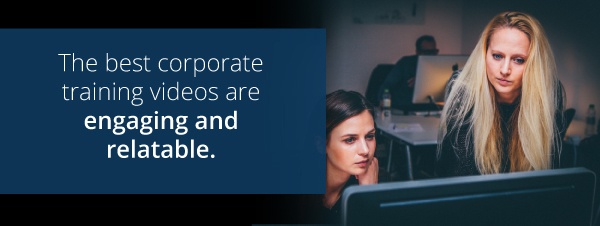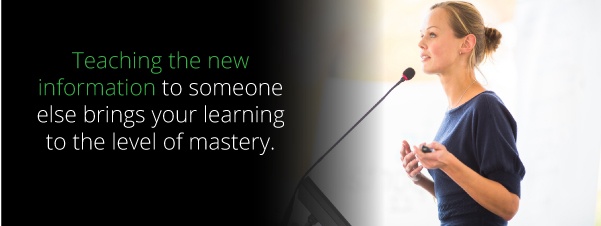One of the biggest struggles with corporate training is getting people to pay attention. The old days of college lectures are long gone. No one wants to sit still and listen to a talking head for over an hour any more. Our digital age has reduced attention spans and increased expectations for any visual presentation.
When you create a training video, you’re competing with fast-paced action dramas, music videos with super-imposed historical facts and the entire internet, where information pops up with a click of the mouse.
Whether they realize it or not, most people are conditioned to expect a constant stream of information and entertainment punctuated by follow-up commentary via text and social media.
Adding elements of interest to your training videos is critical for them to be effective. Whether you work in a technology-driven industry or traditional manufacturing, your training videos need to be modern and engaging to get the results you’re looking for.
Here are some practical tips for creating engaging training videos people will actually want to pay attention to – and learn from.
1. Present the Information in a Way That’s Easy to Understand
It’s especially difficult to hold the attention of your audience when they can’t follow what you’re explaining. Remember: when you’re presenting information to a group, you’re an expert on that particular topic and the people in your audience may have no experience with it at all. Try to think back to the first time you learned about this topic and how you made sense of it.
Be sure to break down the information you’re presenting into small chunks, because people have a limited capacity for taking in new information. You may start by clearly defining some of the key terms you’ll be using. Taking time to clearly identify what you’re talking about will improve the quality of your training video and eliminate confusion at the end.
The best training videos take full advantage of visual representations of the information they present. If you have lots of facts and figures to discuss, use charts and graphs to help your audience visualize them. Information presented in more than one format — that means both audio and video — is easier to understand and remember.

Abstract concepts can be represented with animations to help your audience better visualize them. Most people will only understand a small percentage of the information you tell them. But when you repeat that information in a visual representation, like an animation, you increase the portion of your audience that will understand what you’re saying — and be able to retain and put it into practice.
Another technique to create effective, engaging training videos is to employ reenactments and examples whenever possible. Following up an explanation with an example of it in a real-life scenario is a great way to engage your audience and make your concepts feel more concrete. People may memorize the concepts you present in your online training, but if they can’t apply them in a relatable way, they haven’t truly learned anything.
2. Be Engaging and Natural
The best corporate training videos are engaging and relatable. Video training allows for the inclusion of a human connection. By seeing your face and hearing your voice, or those of engaging actors, your audience will connect with the video and get more out of your message. It’s important to let them see you as natural and human — not as some sort of stuffy corporate figure. If your audience can relate to you and find you approachable in your presentation, they will be more engaged with the video.
Employee training videos are an opportunity to showcase your company culture, too. The employees who are already immersed in the culture should identify with your presentation. New employees who are not fully part of the culture will pick up more cues about it. Overall employee engagement depends on everyone understanding and becoming part of your company culture.

In your position as a manager or trainer, you are expected to embody the corporate culture. When your presentation in the video is natural, the corporate culture shines in a positive light. Everyone who watches that video should want to be just like you on some level. You want to inspire them to take part in the company’s culture and really buy into it.
3. Vary Your Presentation to Counteract Short Attention Spans & Break Up Dense Content
Good corporate training video production incorporates various styles of presentation to keep the interest of the audience. Think about the ways information is presented to people in other venues. The news, for example, is usually a mixture of talking heads and on-the-scene videos. Most modern television shows combine more than one storyline intermixed in small chunks. Magazine articles — either online or in print — are interspersed with photographs to break up the monotony of all those words.
The key here is to find different ways to communicate with your audience and to keep the video lively. No one will remember everything you present if you show it just once. Instead, find different ways to present your information and then mix them up on your video. Saying the same thing more than once will not seem redundant if you do it in different ways, and the repetition is important for learning.

Of course, you don’t want to confuse your audience by jumping around too much in your video. There needs to be a logical transition from one segment to the next. Each segment should be long enough for your audience to make that mental transition and absorb some information. If your audience gets confused or frustrated, they will not continue to pay attention.
4. Evoke Your Employees’ Emotions
Making a video is a lot like making a movie: if it reaches the audience at an emotional level, it will be well-liked and remembered. Of course, the best training videos are not real tear-jerkers. There are other, happier emotions you want to tap into. Your training video should inspire employees to excel, given this new information they’re being presented with.
The best training videos help employees renew their passion for the company and the work they do. No matter what industry you’re in, you can stir up some pride in your employees. Try showing them your own passion for the work the company does and your pride in your product, service and team. Your video can also showcase some employees demonstrating their passion for the job.
Your video will be engaging to your audience if it makes them think about why they do what they do. Once people tap into their passion, the next step is a desire to do it more and better. They will want to use the information you give them to improve their overall performance. With this type of emotional draw, your training video will be very successful.
Creating a personal message with your training video will make it especially engaging. You want people to feel like the video is speaking directly to them. It should have the intimacy of a personal conversation between the employee and the manager. Employees feel important when the management speaks to them individually, and employees who feel important are more engaged.

5. Insist on High-Quality Production
Even if you know nothing about video production, you can tell the difference between a professional job and a DIY video. As much as DIY is a popular trend in many things right now, don’t rely on it for your training videos. Anyone can make a video, it’s true, but the best training videos are engaging and easy to watch. For that, you need a professional to guide the process and produce technically superior quality.
A video that has been professionally edited with good sound and lighting is essential for capturing and maintaining the attention of your audience. If your audience is not engaged, busy counting the number of flaws in your training video or snickering at the funny shadow in each shot, they’re not getting the training you’re trying to deliver.
Watching people in a video who are awkward and nervous is uncomfortable, too. It’s worth the time and money to bring in professional actors to give your video a polished look. When your video looks amateurish, so do you and your company.
6. Keep Videos Short and to the Point
Much like a movie, the best training videos have a beginning, a middle and an end. In other words, they set up a premise or an idea to be explored. Then they present a question, conflict, or problem to solve. Finally, the end of the video brings the material to a logical, impactful conclusion.
If you follow this format, you’ll find it much easier to keep the attention of your audience. Why? Because people are used to consuming video materials this way. Knowing what to expect helps draw people through the video. They want to see the resolution.
If you have a lot of material to present in your training, it would be better to make a couple short videos than to use one long one. This gives you the opportunity to break up your presentation and allow people time to commit what they learn to their long-term memories. The best information retention techniques involve learning small chunks of information, moving them to long-term memory through repetition and practice and then tackling new information.
A really long training video will bore your audience and oversaturate them with information. No matter how engaging you think the subject of your video is, it will lose people’s attention if it goes on too long. When your audience becomes saturated with information and can’t take in any more, they will “zone out” — even if your video is still rolling.
7. Leave Time for Questions
The interactive part of a training session is especially important for learning. People need to be presented with facts and information, but in order to move that information to long-term memory, they need to apply and practice the information. Asking questions while the presentation is still fresh in their minds will help your audience clarify and digest what they learned.
Questions not only provide a chance for clarification, but they also encourage interaction on the topics. This is part of practicing. Before people can put a new concept into practice, they need to be able to talk about it. Using the new information they gained, and the associated vocabulary, people verbally play with ideas and commit them to memory. A lively discussion of the new information following the video presentation can help with this transition.
In the conversations following your presentation, members of your audience can share what they’ve learned with each other. When you teach a concept, you learn it more fully. Knowing a fact is one level of learning, and applying that fact to a situation is another. Teaching the new information to someone else brings your learning to the level of mastery.
The question time at the end of a presentation can move everyone closer to mastery. But here’s the most important part: if no one asks any questions, don’t assume they fully understand the information presented. They may be too confused or overloaded with information to formulate a question. Ask your audience summary questions to see if they got the points you were making in your video.

Contact NextThought Studios for More Information
When you’re ready to get started on your next corporate training video, contact NextThought Studios to make it really engaging. We are a full-service video production company with experience producing high-quality, highly engaging videos.
NextThought Studios has the equipment and the knowledge to produce a professional video for your training needs. Just like in your business, planning is an important first step to executing a flawless project. We have the knowledge and experience to help you plan a training video that comes in on time and without budget creep.
Our experience can help you avoid costly mistakes in the planning process. Shooting your training video in your conference room with a couple of your employees may sound like an easy, low-cost solution, but it can come out expensive in the end. Editing out the effects of bad lighting or awkward actors takes time, if it can be accomplished at all.
Instead, let NextThought Studios assist you in creating a professional training video from the start. We’ll use our lighting and sound equipment to get the best raw footage possible. We’ll shoot b-roll to incorporate into the final cut, infusing added company culture and personality. We can even create on-screen graphics that help you illustrate your points better, making your training video even more effective.
Our team includes messaging experts who can work with you to get your point across to the target audience. Using a combination of visual and auditory communication tools, we can give you the best chance of training your people and inspiring their work on the first run-through.
You know your industry and the information you need to present in your next training video. We know how to make that information clear and relatable to your audience. Your training video will be laser-targeted to hold the attention, inform the minds and inspire the work of your employees.
For more information on creating excellent training videos, or to get a quote for an upcoming project, contact NextThought Studios today!

Janelle Bevan, M.A.
Janelle has produced and project-managed a wide array of videos ranging from corporate commercials to long-form documentaries. While completing her Master’s degree at the University of Oklahoma, she served as the graduate assistant to the department chair for Creative Media. Janelle has worked with many nationally recognized organizations, creating documentaries for the National Association of Broadcasters, designing and editing instructional videos for the Federal Emergency Management Agency, and producing the 2015 Broadcast Education Association awards show in Las Vegas. Janelle is a six-time Telly Award winner and won a 2016 Emmy for her documentary featuring a collaboration from three executive producers of AMC’s The Walking Dead. Janelle served as NextThought’s Director of Post-Production and Media Management and helped facilitate over 1,000 videos during her time at NextThought.
Recent Posts

The 6 Best Educational Video Production Companies (2025)
February 28, 2025 9 Min Read

AI-Powered Soft Skills Coaching, Anytime, Anywhere
October 3, 2024 3 Min Read

Step-by-Step Guide to Creating Effective Training Materials
July 11, 2024 4 Min Read

